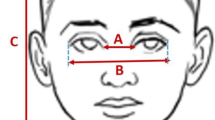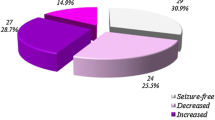Abstract
This study investigates the impact of generalized tonic–clonic seizures (GTCS) and antiepileptic drugs (AED) during pregnancy on gestational age (GA) and anthropometric data of newborns. One hundred twenty-nine singleton pregnancies resulting in live births from September 1999 to October 2010 in 106 women with epilepsy on AED therapy, recorded within the framework of the EURAP (International Registry of Antiepileptic Drugs and Pregnancy) program at the Department of Neurology, Medical University Innsbruck, Austria, were studied. Occurrence of ≥1 GTCS during pregnancy was associated with a shorter GA [median (range) 37.5 [35.1–41.6] vs. 39.7 [29.1–46.3] weeks; p ≤ 0.001], an overall five times higher preterm risk (p = 0.042) and a reduced birth weight in boys (2,900 [2,050–3,870] vs. 3,205 [1,575–4,355] g; p = 0.040). In primipara, when compared to multipara, GTCS ≥1 significantly reduced the GA (37.9 [35.1–41.6] vs. 39.7 [29.4–44.9] weeks; p = 0.020) and raised the incidence of low birth weight (LBW) (p = 0.022) in neonates. Antiepileptic drug polytherapy significantly increased the risk for small-for-gestational-age regarding weight (SGAW; p = 0.035) and regarding weight and/or length (SGAW/L; p = 0.046) when compared to monotherapy. GTCS during pregnancy was associated with diverse negative effects comprising shorter GA, an increased incidence of prematurity and LBW in primiparous women. Furthermore, AED polytherapy was correlated with an enhanced risk for SGA delivery. Re-evaluating the need for drug therapy (in particular polytherapy), maintaining seizure control for a given period before pregnancy and counseling about the importance of preventing GTCS might improve pregnancy outcome in women with epilepsy.

Similar content being viewed by others
References
Seizure control and treatment in pregnancy: observations from the EURAP epilepsy pregnancy registry (2006). Neurology 66 (3):354-360
Borthen I, Eide MG, Daltveit AK, Gilhus NE (2011) Obstetric outcome in women with epilepsy: a hospital-based, retrospective study. BJOG 118(8):956–965
Chen YH, Chiou HY, Lin HC, Lin HL (2009) Affect of seizures during gestation on pregnancy outcomes in women with epilepsy. Arch Neurol 66(8):979–984
Katz JM, Pacia SV, Devinsky O (2001) Current management of epilepsy and pregnancy: fetal outcome, congenital malformations, and developmental delay. Epilepsy Behav 2(2):119–123
Richmond JR, Krishnamoorthy P, Andermann E, Benjamin A (2004) Epilepsy and pregnancy: an obstetric perspective. Am J Obstet Gynecol 190(2):371–379
Veiby G, Daltveit AK, Engelsen BA, Gilhus NE (2009) Pregnancy, delivery, and outcome for the child in maternal epilepsy. Epilepsia 50(9):2130–2139
Lin HL, Chen YH, Lin HC, Lin HC (2009) No increase in adverse pregnancy outcomes for women receiving antiepileptic drugs. J Neurol 256(10):1742–1749
Borthen I, Eide MG, Veiby G, Daltveit AK, Gilhus NE (2009) Complications during pregnancy in women with epilepsy: population-based cohort study. BJOG 116(13):1736–1742
Viinikainen K, Heinonen S, Eriksson K, Kalviainen R (2006) Community-based, prospective, controlled study of obstetric and neonatal outcome of 179 pregnancies in women with epilepsy. Epilepsia 47(1):186–192
Almgren M, Kallen B, Lavebratt C (2009) Population-based study of antiepileptic drug exposure in utero—influence on head circumference in newborns. Seizure 18(10):672–675
Hvas CL, Henriksen TB, Ostergaard JR, Dam M (2000) Epilepsy and pregnancy: effect of antiepileptic drugs and lifestyle on birthweight. BJOG 107(7):896–902
Oyen N, Vollset SE, Eide MG, Bjerkedal T, Skjaerven R (2007) Maternal epilepsy and offsprings’ adult intelligence: a population-based study from Norway. Epilepsia 48(9):1731–1738
Sawhney H, Vasishta K, Suri V, Khunnu B, Goel P, Sawhney IM (1996) Pregnancy with epilepsy–a retrospective analysis. Int J Gynaecol Obstet 54(1):17–22
Wide K, Winbladh B, Tomson T, Kallen B (2000) Body dimensions of infants exposed to antiepileptic drugs in utero: observations spanning 25 years. Epilepsia 41(7):854–861
Battino D, Kaneko S, Andermann E, Avanzini G, Canevini MP, Canger R, Croci D, Fumarola C, Guidolin L, Mamoli D, Molteni F, Pardi G, Vignoli A, Fukushima Y, Kan R, Takeda A, Nakane Y, Ogawa Y, Dansky L, Oguni M, Lopez-Ciendas I, Sherwin A, Andermann F, Seni MH, Goto M et al (1999) Intrauterine growth in the offspring of epileptic women: a prospective multicenter study. Epilepsy Res 36(1):53–60
Gaily EK, Granstrom ML, Hiilesmaa VK, Bardy AH (1990) Head circumference in children of epileptic mothers: contributions of drug exposure and genetic background. Epilepsy Res 5(3):217–222
Wen SW, Zhou J, Yang Q, Fraser W, Olatunbosun O, Walker M (2008) Maternal exposure to folic acid antagonists and placenta-mediated adverse pregnancy outcomes. CMAJ 179(12):1263–1268
Andersen LG, Angquist L, Eriksson JG, Forsen T, Gamborg M, Osmond C, Baker JL, Sorensen TI (2010) Birth weight, childhood body mass index and risk of coronary heart disease in adults: combined historical cohort studies. PLoS ONE 5(11):e14126
Kaijser M, Bonamy AK, Akre O, Cnattingius S, Granath F, Norman M, Ekbom A (2008) Perinatal risk factors for ischemic heart disease: disentangling the roles of birth weight and preterm birth. Circulation 117(3):405–410
Osler M, Lund R, Kriegbaum M, Andersen AM (2009) The influence of birth weight and body mass in early adulthood on early coronary heart disease risk among Danish men born in 1953. Eur J Epidemiol 24(1):57–61
Rich-Edwards JW, Kleinman K, Michels KB, Stampfer MJ, Manson JE, Rexrode KM, Hibert EN, Willett WC (2005) Longitudinal study of birth weight and adult body mass index in predicting risk of coronary heart disease and stroke in women. BMJ 330(7500):1115
Proposal for revised classification of epilepsies and epileptic syndromes. Commission on Classification and Terminology of the International League Against Epilepsy (1989). Epilepsia 30 (4):389-399
Hernandez-Diaz S, Werler MM, Walker AM, Mitchell AA (2000) Folic acid antagonists during pregnancy and the risk of birth defects. N Engl J Med 343(22):1608–1614
Tomson T, Battino D, Bonizzoni E, Craig J, Lindhout D, Sabers A, Perucca E, Vajda F (2011) Dose-dependent risk of malformations with antiepileptic drugs: an analysis of data from the EURAP epilepsy and pregnancy registry. Lancet Neurol 10(7):609–617
LaJoie J, Moshe SL (2004) Effects of seizures and their treatment on fetal brain. Epilepsia 45(Suppl 8):48–52
Teramo K, Hiilesmaa V, Bardy A, Saarikoski S (1979) Fetal heart rate during a maternal grand mal epileptic seizure. J Perinat Med 7(1):3–6
Tatum WO (2009) Balancing the risks to the fetus from epileptic seizures and antiepileptic drug exposure in pregnancy. Expert Rev Neurother 9(12):1707–1708
Vajda FJ, Hitchcock A, Graham J, O’Brien T, Lander C, Eadie M (2008) Seizure control in antiepileptic drug-treated pregnancy. Epilepsia 49(1):172–176
Meador KJ, Baker GA, Finnell RH, Kalayjian LA, Liporace JD, Loring DW, Mawer G, Pennell PB, Smith JC, Wolff MC (2006) In utero antiepileptic drug exposure: fetal death and malformations. Neurology 67(3):407–412
Morrow J, Russell A, Guthrie E, Parsons L, Robertson I, Waddell R, Irwin B, McGivern RC, Morrison PJ, Craig J (2006) Malformation risks of antiepileptic drugs in pregnancy: a prospective study from the UK epilepsy and pregnancy register. J Neurol Neurosurg Psychiatry 77(2):193–198
Patsalos PN, Berry DJ, Bourgeois BF, Cloyd JC, Glauser TA, Johannessen SI, Leppik IE, Tomson T, Perucca E (2008) Antiepileptic drugs—best practice guidelines for therapeutic drug monitoring: a position paper by the subcommission on therapeutic drug monitoring, ILAE Commission on therapeutic strategies. Epilepsia 49(7):1239–1276
Ludwig DS, Currie J (2010) The association between pregnancy weight gain and birthweight: a within-family comparison. Lancet 376(9745):984–990
Conflicts of interest
The authors have no conflicts of interest to declare in relation to this study.
Ethical standard
We confirm that we have read the Journal’s position on issues involved in ethical publication and affirm that this report is consistent with those guidelines.
Author information
Authors and Affiliations
Corresponding author
Rights and permissions
About this article
Cite this article
Rauchenzauner, M., Ehrensberger, M., Prieschl, M. et al. Generalized tonic–clonic seizures and antiepileptic drugs during pregnancy—a matter of importance for the baby?. J Neurol 260, 484–488 (2013). https://doi.org/10.1007/s00415-012-6662-8
Received:
Revised:
Accepted:
Published:
Issue Date:
DOI: https://doi.org/10.1007/s00415-012-6662-8




